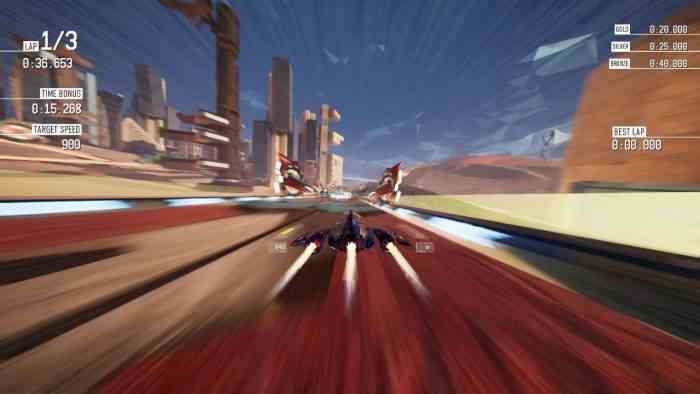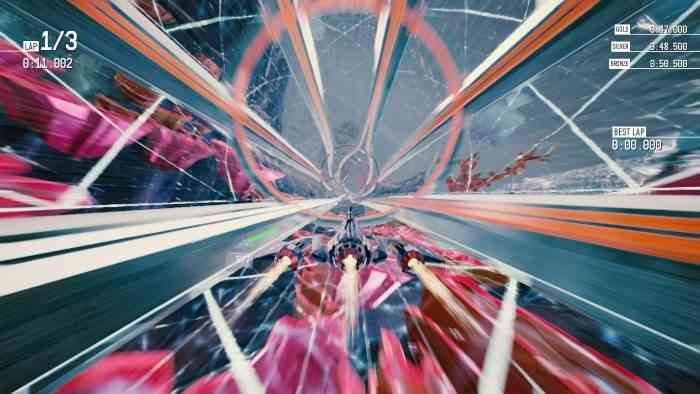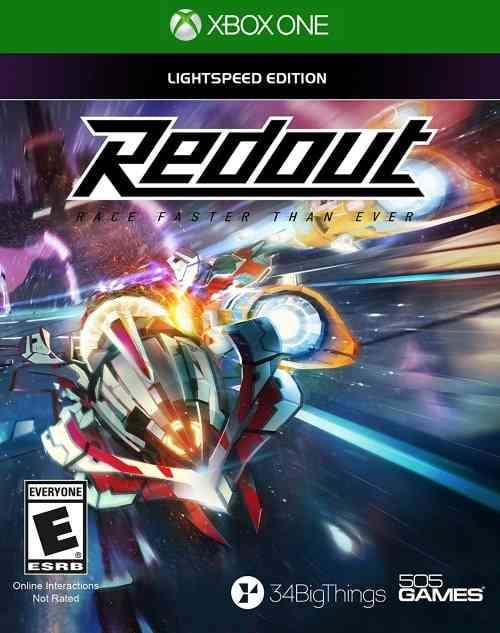Redout: Lightspeed Edition Review
Fans of futuristic racers from days past like F-Zero and Wipeout should take notice of Redout. Available since 2016 on PC and as a launch title for the Nintendo Switch, the newly titled Redout: Lightspeed Edition has arrived on the Xbox One and PlayStation 4. In games like this, gravity takes a bit of a backseat and vehicles hover along lengthy tracks filled with twists, jumps, and loops.
Redout doesn’t provide much of a story. You’re in the future, the world has gone to crap and now racing has evolved into this competition. To begin with, you’ll need to choose one of six different sponsors. Each sponsor has four separate vehicles, one for each class, which can be upgraded in four different ways. You’ll start off as a Class 1 driver, but as you compete, you’ll earn experience that’ll eventually earn you access to Class 2, 3 and 4 vehicles and races. You’ll also earn money that you’ll need to buy upgrades, items, and new vehicles. Each subsequent class is designed to be faster and more challenging. It’s also worth noting that you have to use the appropriate class vehicle for each race. In other words, you can’t use a fast Class 3 vehicle in a Class 1 race. I didn’t mind the class system since it gave me something specific to work towards.
One of the highlights of Redout is the sheer amount of variety included. There are over 11 event types, from time trials to races. As you level up, you’ll unlock more events, and thankfully you can pick from any unlocked event so you’re rarely stuck with an event you don’t particularly like (I’m talking about you “Survival”). There are many different tracks spread throughout 5 different locations which include Egypt, Alaska, and some out-of-this-world locations that I won’t spoil here! One of the coolest events is the “Boss” event. This event features a couple different tracks that are mish-mashed together to create one seamless, extra long race. You’ll be racing in one location, drive through a checkpoint and magically appear in another section from a separate location – it’s really quite cool.

Redout isn’t perfect though. For example, controlling your vehicle requires both thumbsticks – one to turn and one to control drift and pitch. I found the pitch element annoying and unnecessary. Essentially, you have to raise your vehicles front end whenever you encounter any upwards vertically. If you don’t, your front end will drag along the ground (despite the fact we’re hovering!) and you’ll lose speed and health. This mechanic is just too difficult to manage at high speeds and ultimately should have been scrapped.
Level design is absolutely vital for racers and unfortunately, there are some glaring issues here – particularly with jumping over gaps. In almost every level, there is at least one gap that you’ll need to jump over. Taking massive jumps over vast gaps is a visual treat but it is damn near impossible to judge the landing while you’re in the air, which inevitably leads to death. With practice, these jumps do become a bit more manageable, but then these same tracks will present new issues when you’re in racing in faster vehicles. In Class 3 and 4 events, you’ll sometimes take a jump at such a high speed that you’ll overshoot the landing or just fly off into space. I shouldn’t have to slow down before a jump just to ensure I don’t miss the landing. Practice does make perfect here, but until then, expect a lot of missed landings, costing you the lead.
______________________________
“Taking massive jumps over vast gaps are a visual treat but it is damn near impossible to judge the landing while you’re in the air…”
Visually, Redout can’t compete with the Forza franchise, but when you’re blasting along at speeds exceeding 1000 kilometer’s an hour, it actually looks pretty cool. Each location has features that stand out, like raging volcanoes or sprawling cities. There are a lot of visual cues along the courses indicating which way to turn or if a side rail is missing which is a nice touch. The music is a collection of electronica tracks that actually mirrors the racing. The music becomes more intense the faster you drive and when you take a jump the track drops the melody leaving just the beat as you soar through the air. While I wasn’t a huge fan of the music, I respect how they integrated it into the driving creating a more dynamic sound.

Redout features a couple multiplayer options which help round the package out. There is a local, split-screen mode that allows two people to race against each other. Then there is an online mode that allows up to 12 players to compete in all the various events and locations. My biggest disappointment was that competing online didn’t benefit the single player campaign at all. Earning experience and money in the online races would be a nice incentive to play online.
Redout is definitely the type of racing game that fans of F-Zero and Wipeout will flock to. The single player campaign brings a substantial amount of content with it. One thing I really loved was that even if you lose an event, you’ll still earn some experience and money – a huge help for beginners that are having a difficult time. Redout features three difficulty settings, which can be adjusted at any time. The multiplayer mode offers most of the tracks and events from the single player campaign and can be played locally or online. There are some disappointing faults with Redout. I found the AI can be overly aggressive and often it seemed they were given an unfair advantage. Plus that whole pitch adjustment aspect is completely unnecessary. If you’re looking for a fun, futuristic racer – you really can’t go wrong with Redout. Despite its flaws, I kept coming back for more. It’s quite possible that developer 34BigThings could have a successful franchise in their hands – I suppose we’ll know for sure in the future.
*** Xbox One code provided by the publisher ***
The Good
- Huge variety of courses
- Lots of event types
- Very fast with no noticeable drops in framerate
- Local and online multiplayer
The Bad
- Overly aggressive AI
- Some poor level design choices
- Unnecessary pitch mechanic

